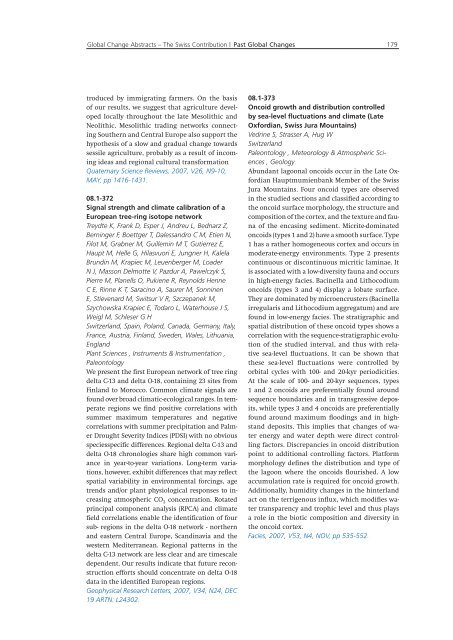Global Change Abstracts The Swiss Contribution - SCNAT
Global Change Abstracts The Swiss Contribution - SCNAT
Global Change Abstracts The Swiss Contribution - SCNAT
You also want an ePaper? Increase the reach of your titles
YUMPU automatically turns print PDFs into web optimized ePapers that Google loves.
<strong>Global</strong> <strong>Change</strong> <strong>Abstracts</strong> – <strong>The</strong> <strong>Swiss</strong> <strong>Contribution</strong> | Past <strong>Global</strong> <strong>Change</strong>s<br />
troduced by immigrating farmers. On the basis<br />
of our results, we suggest that agriculture developed<br />
locally throughout the late Mesolithic and<br />
Neolithic. Mesolithic trading networks connecting<br />
Southern and Central Europe also support the<br />
hypothesis of a slow and gradual change towards<br />
sessile agriculture, probably as a result of incoming<br />
ideas and regional cultural transformation<br />
Quaternary Science Reviews, 2007, V26, N9-10,<br />
MAY, pp 1416-1431.<br />
08.1-372<br />
Signal strength and climate calibration of a<br />
European tree-ring isotope network<br />
Treydte K, Frank D, Esper J, Andreu L, Bednarz Z,<br />
Berninger F, Boettger T, Dalessandro C M, Etien N,<br />
Filot M, Grabner M, Guillemin M T, Gutierrez E,<br />
Haupt M, Helle G, Hilasvuori E, Jungner H, Kalela<br />
Brundin M, Krapiec M, Leuenberger M, Loader<br />
N J, Masson Delmotte V, Pazdur A, Pawelczyk S,<br />
Pierre M, Planells O, Pukiene R, Reynolds Henne<br />
C E, Rinne K T, Saracino A, Saurer M, Sonninen<br />
E, Stievenard M, Switsur V R, Szczepanek M,<br />
Szychowska Krapiec E, Todaro L, Waterhouse J S,<br />
Weigl M, Schleser G H<br />
Switzerland, Spain, Poland, Canada, Germany, Italy,<br />
France, Austria, Finland, Sweden, Wales, Lithuania,<br />
England<br />
Plant Sciences , Instruments & Instrumentation ,<br />
Paleontology<br />
We present the first European network of tree ring<br />
delta C-13 and delta O-18, containing 23 sites from<br />
Finland to Morocco. Common climate signals are<br />
found over broad climatic-ecological ranges. In temperate<br />
regions we find positive correlations with<br />
summer maximum temperatures and negative<br />
correlations with summer precipitation and Palmer<br />
Drought Severity Indices (PDSI) with no obvious<br />
speciesspecific differences. Regional delta C-13 and<br />
delta O-18 chronologies share high common variance<br />
in year-to-year variations. Long-term variations,<br />
however, exhibit differences that may reflect<br />
spatial variability in environmental forcings, age<br />
trends and/or plant physiological responses to increasing<br />
atmospheric CO 2 concentration. Rotated<br />
principal component analysis (RPCA) and climate<br />
field correlations enable the identification of four<br />
sub- regions in the delta O-18 network - northern<br />
and eastern Central Europe, Scandinavia and the<br />
western Mediterranean. Regional patterns in the<br />
delta C-13 network are less clear and are timescale<br />
dependent. Our results indicate that future reconstruction<br />
efforts should concentrate on delta O-18<br />
data in the identified European regions.<br />
Geophysical Research Letters, 2007, V34, N24, DEC<br />
19 ARTN: L24302.<br />
179<br />
08.1-373<br />
Oncoid growth and distribution controlled<br />
by sea-level fluctuations and climate (Late<br />
Oxfordian, <strong>Swiss</strong> Jura Mountains)<br />
Vedrine S, Strasser A, Hug W<br />
Switzerland<br />
Paleontology , Meteorology & Atmospheric Sciences<br />
, Geology<br />
Abundant lagoonal oncoids occur in the Late Oxfordian<br />
Hauptmumienbank Member of the <strong>Swiss</strong><br />
Jura Mountains. Four oncoid types are observed<br />
in the studied sections and classified according to<br />
the oncoid surface morphology, the structure and<br />
composition of the cortex, and the texture and fauna<br />
of the encasing sediment. Micrite-dominated<br />
oncoids (types 1 and 2) have a smooth surface. Type<br />
1 has a rather homogeneous cortex and occurs in<br />
moderate-energy environments. Type 2 presents<br />
continuous or discontinuous micritic laminae. It<br />
is associated with a low-diversity fauna and occurs<br />
in high-energy facies. Bacinella and Lithocodium<br />
oncoids (types 3 and 4) display a lobate surface.<br />
<strong>The</strong>y are dominated by microencrusters (Bacinella<br />
irregularis and Lithocodium aggregatum) and are<br />
found in low-energy facies. <strong>The</strong> stratigraphic and<br />
spatial distribution of these oncoid types shows a<br />
correlation with the sequence-stratigraphic evolution<br />
of the studied interval, and thus with relative<br />
sea-level fluctuations. It can be shown that<br />
these sea-level fluctuations were controlled by<br />
orbital cycles with 100- and 20-kyr periodicities.<br />
At the scale of 100- and 20-kyr sequences, types<br />
1 and 2 oncoids are preferentially found around<br />
sequence boundaries and in transgressive deposits,<br />
while types 3 and 4 oncoids are preferentially<br />
found around maximum floodings and in highstand<br />
deposits. This implies that changes of water<br />
energy and water depth were direct controlling<br />
factors. Discrepancies in oncoid distribution<br />
point to additional controlling factors. Platform<br />
morphology defines the distribution and type of<br />
the lagoon where the oncoids flourished. A low<br />
accumulation rate is required for oncoid growth.<br />
Additionally, humidity changes in the hinterland<br />
act on the terrigenous influx, which modifies water<br />
transparency and trophic level and thus plays<br />
a role in the biotic composition and diversity in<br />
the oncoid cortex.<br />
Facies, 2007, V53, N4, NOV, pp 535-552.

















